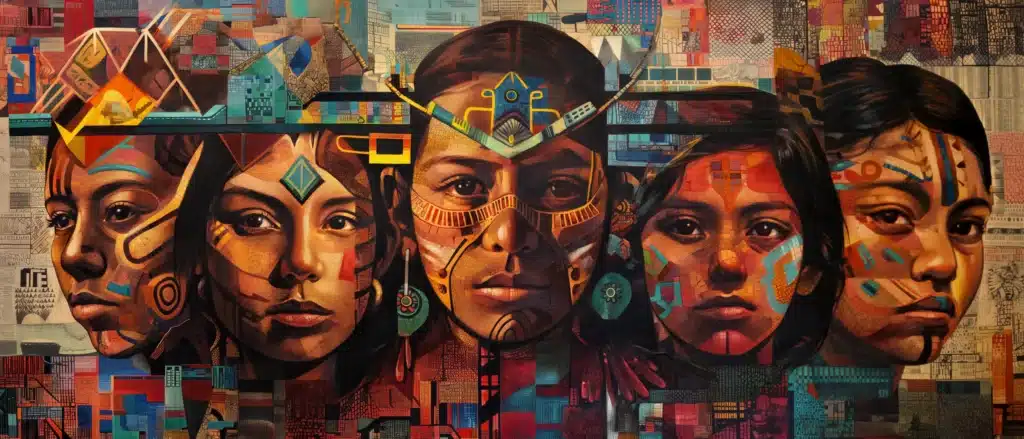
Mexica pronounced (meh-shee-ka) is a broad term used on here to refer the collective of Mexican area Indigenous peoples of which there are many.
Most people who claim Mexica today cannot actually claim actual Mexicah-Tenochca lineage. More accurately contemporary “Mexica” are comprised of numerous Indigenous nations within Mexico (“Meso-America.”) Descendants of the P’urhepecha, Apache, Zapotec, Raramuri, and Huichol are just a handful of the many nations who make up modern Mexicas as it pertains to this website’s education strategy.
On this site, the term Mexica is used with the intention of giving Chicanxs or so-called Latinxs of Amerindian heritage, an identity home base and placeholder while they travel on their road of Indigenous reclamation and self-healing.
Using the word “Mexica” doesn’t mean we’re suggesting all people from Mesoamerica (or “Mesox”) need to adopt it for nationalistic purposes. However, we understand that the destruction of MesoX people was a systematic process. We also understand that our Indigenous reclamation process needs to reverse engineer that colonization. With that, Mexica as an identity is a logical step in the reverse engineering process.
It’s important to highlight how the Mexica (Aztec)/Nahua language and social concepts were utilized by the Spaniards as a strategic colonization measure. This was done to create a unified linguistic and cultural framework that facilitated the easier communication, conversion to Catholicism, and control over the diverse Indigenous populations within the Mesoamerican region. This historical maneuvering by the Spaniards underscores the complexity of the “Mexica” identity and enriches the significance of its adoption today as part of the Indigenous reclamation and healing journey.
Learning resource truths need to be abundant and popular in historical resources as a good first step, and identity placeholder to employ in the Systematic Rebuilding of Indigenous consciousness for “Meso-american” peoples living in the U.S.
The historical documentation and resources related to the Mexica are plentiful, providing a rich repository of references and models for cultural and social repair for people of Mesoamerican heritage. This abundance of information serves as an invaluable asset in our journey towards reclaiming and revitalizing our ancestral identities and practices. It is noteworthy that, while the Mexica and Nahuas held distinct positions within the Mesoamerican tapestry, many nations and peoples within this region shared fundamental qualities, knowledge systems, and worldviews. This common ground suggests that the wisdom and practices of the Mexica/Nahua can offer insights and inspiration for a broader spectrum of Mesoamerican descendants, aiding in the collective effort to mend and reclaim our Indigenous selves.
The term “Aztec,” widely attributed to our ancestors, was popularized by historian William H. Prescott in the 19th century. However, this term does not accurately reflect the diverse groups that migrated from the mythical Aztlan to the Basin of Mexico around the 12th century, notably including the Mexica, the founders of Tenochtitlan. “Mexica,” pronounced (meh-shee-ka), more accurately describes these particular ancestors, who were part of the broader Nahua family of Indigenous peoples, encompassing many nations.
Before the arrival of Spanish, Latin, and Christian influences, the term “Aztec” was seldom used; “Tenochca” (those from Tenochtitlan) was more common, highlighting the centrality of Tenochtitlan in the Mexicah civilization. The Mexicah’s dominance over what is today known as Mexico at the time of European arrival played a pivotal role in the naming of the country. This historical significance also influences the modern terms “Mexican,” “Mexicano,” and “Chicano, etc.”
Given the transformative encounter between the Mexica and European invaders, alongside a lack of cultural education in the U.S., it’s understandable that many, including Chicanos, would default to using “Aztec” to describe all Mexicans. This, however, is a simplification that overlooks the rich tapestry of Indigenous nations within Mexico.
While recognizing the term “Aztec” for its utility we understand that is a more recognizable term to start engagement, especially in educational contexts where many haven’t been able to access more accurate historical knowledge. Using “Mexica” not only promotes greater accuracy, but also educates the public about a term that might be unfamiliar to them. It’s not about discarding the term “Aztec” entirely but understanding its origins, limitations, and the broader context of Mexica and Nahua peoples’ history and identity. This approach allows us to navigate the balance between ensuring historical accuracy and creating deeper understanding, all the while honoring the profoundness of our Mesoamerican heritage.
Mexica roughly means ” people of the navel of the moon” from Nahuatl metztli (moon) and xictli (navel.) Nahuatl is a very profound language that has layers of meaning and symbolism.
The language of the Mexica is Nahuatl. It is the most spoken Indigenous language in North America. From what I have gathered it is the most recorded and documented of all Indigenous languages in the “Americas.”
It is estimated that 1.5 million speak the language but I am confident the number is much greater. A couple reasons being the unlikeliness that the many populations of native people would even partake in such a census, as well as the resurgence of Indigenous identity and practice of Nahuatl among Chicanah and other so-called “Latino” peoples.